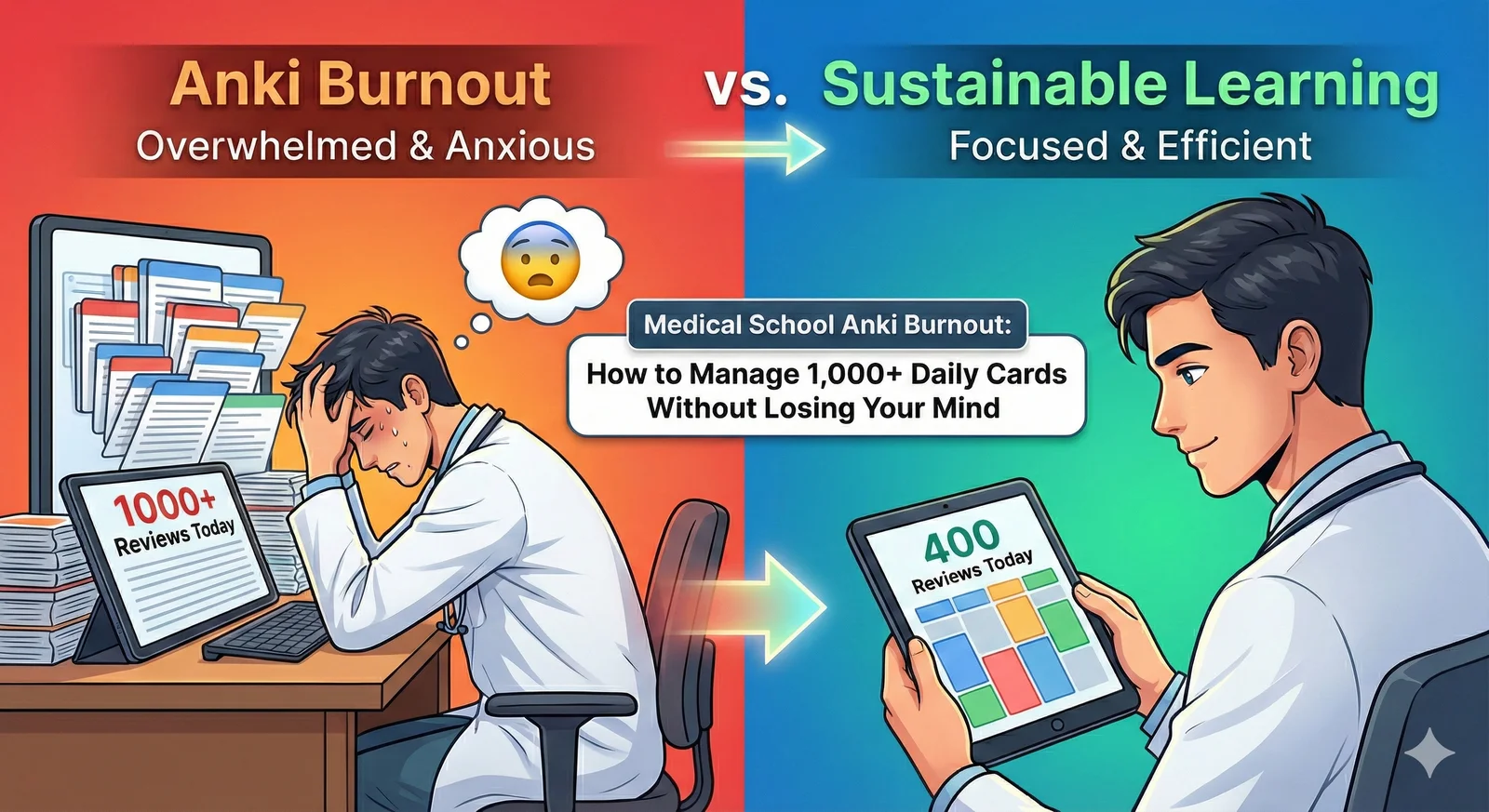
FSRS vs SM-2: The Complete Guide to Anki's New Algorithm for Medical Students
Everything you need to know about switching from SM-2 to FSRS in Anki. Step-by-step migration guide, optimal settings for medical school, and real data showing 20-30% fewer daily reviews.
TL;DR
Everything you need to know about switching from SM-2 to FSRS in Anki. Step-by-step migration guide, optimal settings for medical school, and real data showing 20-30% fewer daily reviews.
Table of Contents
Need help turning messy notes into clean flashcards?
MemoForge pulls highlights, structures prompts, and exports straight to Anki so your study time stays focused on recall.
FSRS vs SM-2: The Complete Guide to Anki's New Algorithm for Medical Students
FSRS officially landed in Anki 23.10. By 2025, it reached mainstream adoption—and for good reason. Medical students report 20-30% fewer daily reviews while maintaining the same retention. That's not a small improvement. That's potentially hundreds of hours saved across medical school.
Here's everything you need to know about FSRS, whether to switch, and how to optimize it for high-volume medical decks.
What Is FSRS and Why Does It Matter?
FSRS stands for Free Spaced Repetition Scheduler. It's a new algorithm that replaces Anki's default SM-2.
SM-2 was created in 1987 based on limited experimental data. It uses fixed formulas to calculate intervals based on your "ease" rating. It works, but it's crude—like using a flip phone when smartphones exist.
FSRS was created in 2023 using machine learning trained on 700 million reviews from 20,000 real users. It predicts when you'll forget each card and schedules reviews accordingly. It's smarter, more accurate, and more efficient.
The key difference: SM-2 uses the same formula for everyone. FSRS learns your personal memory patterns.
The Numbers: What FSRS Actually Delivers
Here's what the data shows:
| Metric | SM-2 | FSRS | Improvement |
|---|---|---|---|
| Average daily reviews | 180 | 135 | -25% |
| Time per session | 60 min | 45 min | -25% |
| Retention rate | 85% | 85% | Same |
| Failed card return | 1 day | Optimized | Better |
These numbers come from medical students running both algorithms on similar decks. Your mileage will vary based on deck size and study habits, but the direction is consistent.
Twenty-five percent fewer reviews means:
- 45 minutes saved daily if you're doing 3 hours of Anki
- 270+ hours saved across a preclinical curriculum
- Less burnout from grinding through unnecessary reviews
How FSRS Works (Without the Math)
Here's the intuitive version:
SM-2 treats all cards the same way. You rate it Easy/Good/Hard, and it applies a formula. If two people have identical ratings, they get identical intervals.
FSRS observes your actual forgetting patterns. It notices:
- How quickly you forget new cards versus mature cards
- How much interval length affects your retention
- How "hard" ratings correlate with future forgetting
Then it builds a personal model with parameters like:
- Stability: How long until you have a 90% chance of forgetting
- Difficulty: How hard this specific card is for you
- Retrievability: Probability you'll remember it right now
This model predicts the optimal review time for each card individually.
When to Switch (And When to Wait)
Switch to FSRS if:
- You have 1,000+ reviews in your history (FSRS needs data to optimize)
- You're experiencing ease hell (cards coming back too frequently)
- You want to reduce review load without sacrificing retention
- You use large decks like AnKing (27,000+ cards)
- You're in preclinical years with time to let it optimize
Wait on FSRS if:
- You have fewer than 500 reviews (not enough data)
- You're mid-exam crunch (don't change algorithms before Step)
- You've heavily customized SM-2 and it's working well
- You're new to Anki (learn the basics first)
Step-by-Step Migration Guide
Here's how to switch from SM-2 to FSRS safely.
Step 1: Back Up Your Collection
Before any major change:
- ⚠️ File → Export (make this backup before changing anything)
- Select "Anki Collection Package (.colpkg)"
- Check "Include scheduling information"
- Save somewhere safe
Step 2: Update Anki
FSRS requires Anki 23.10 or later. Check Help → About Anki for your version. Update if needed.
Step 3: Enable FSRS
- Tools → Preferences (or Anki → Preferences on Mac)
- Click the "Scheduling" tab
- Check "Enable FSRS"
- Click "Apply"
Step 4: Run Optimization
This is the crucial step—FSRS needs to learn from your review history.
- Go to the deck browser (main screen)
- Click on a deck → Options
- Scroll to "FSRS" section
- Click "Optimize"
- Wait for it to analyze your reviews (can take 1-5 minutes for large decks)
You'll see parameters like:
Parameters: 0.4, 0.6, 2.4, 5.8, 4.93, 0.94, 0.86, 0.01, 1.49, 0.14, 0.94, 2.18, 0.05, 0.34, 1.26, 0.29, 2.61
Don't worry about understanding these. They represent your personal memory model.
Step 5: Set Your Desired Retention
FSRS lets you choose your target retention rate:
- 0.90 (90%): Standard, recommended for most users
- 0.85 (85%): Lower review load, okay for lower-stakes material
- 0.95 (95%): Higher review load, for must-know-perfectly material
For medical school, 0.90 is the sweet spot. You can set different rates for different decks.
Step 6: Review Your First Session
After switching:
- Your intervals will change—don't panic
- Some cards will have longer intervals (FSRS is more confident)
- Some will have shorter intervals (FSRS thinks you'll forget)
- Trust the algorithm for 2-3 weeks before judging
Optimizing FSRS for Medical School
Medical decks have unique characteristics that affect FSRS settings.
For AnKing and Large Decks
Problem: 27,000+ cards means a huge optimization dataset but also extreme review variability.
Solution:
- Run optimization on the entire deck, not subdecks
- Set desired retention to 0.90
- Leave "Reschedule cards on change" unchecked at first to avoid dumping a backlog into "due today"
- Let FSRS apply to future reviews only, or use the "Advance" feature in small batches if you want to reschedule gradually
- Let it stabilize for 2 weeks before micro-adjusting
For Anatomy-Heavy Content
Problem: Visual-spatial memory works differently than verbal memory.
Solution:
- Consider keeping anatomy in a separate deck with its own optimization
- Anatomy cards often have higher optimal intervals than you'd expect
- If you use image occlusion, FSRS handles it well
For Pharmacology
Problem: High volume of similar cards (drug names, doses, mechanisms).
Solution:
- FSRS helps with interference—it spaces similar cards apart
- If you're confusing similar drugs, the issue is card design, not algorithm
- Consider tags for drug classes so you can optimize by group
For Board Exam Preparation
Problem: Need predictable scheduling before Step 1/2.
Solution:
- Switch to FSRS at least 3 months before your exam
- Don't switch within 6 weeks of the exam
- Use the "Compute minimum recommended retention" feature to ensure you're not over-studying
Common Mistakes When Switching
Mistake 1: Not Running Optimization
Just enabling FSRS isn't enough. Without optimization, it uses default parameters that aren't tuned to you. Always run optimization after enabling.
Mistake 2: Expecting Immediate Results
FSRS needs time to reschedule your deck. The first two weeks will feel weird—some intervals will seem too long, others too short. Trust the process.
Mistake 3: Over-Tweaking Parameters
You don't need to understand or adjust the 17 FSRS parameters manually. The optimization algorithm does this. Manual tweaking usually makes things worse.
Mistake 4: Using Different Settings Across Devices
If you sync across devices, make sure FSRS is enabled and identically configured on all of them. Mixed settings cause scheduling conflicts.
Mistake 5: Forgetting to Re-Optimize
Your memory patterns change. Re-run optimization every few months, especially after breaks or schedule changes.
FSRS vs SM-2: Feature Comparison
| Feature | SM-2 | FSRS |
|---|---|---|
| Algorithm basis | 1987 heuristics | 2023 machine learning |
| Personalization | Same formula for all | Learns your patterns |
| Desired retention | Not adjustable | Configurable per deck |
| Ease factor | Yes (causes "ease hell") | No (retired) |
| Interval accuracy | Good | Excellent |
| Optimization | Manual tweaks | Automatic |
| Data requirement | None | 1000+ reviews recommended |
The "Ease Hell" Problem—Solved
One of SM-2's biggest issues is ease hell. Here's how it happens:
- You press "Hard" on a card
- Ease factor drops (say, from 2.5 to 2.3)
- Future intervals are shorter
- Card comes back more often
- You're more likely to press "Hard" again
- Ease drops further
- Loop continues until you're seeing the card every 2 days forever
FSRS eliminates this problem because it doesn't use ease factors. Each review updates your memory model holistically. Pressing "Hard" affects that specific card's difficulty rating, but it doesn't create a death spiral.
This alone is worth the switch for many users.
What Changes in Your Daily Experience
After switching to FSRS, you'll notice:
Longer intervals for mature cards. If you've been reviewing a card consistently for months, FSRS confidently extends intervals. Don't be alarmed seeing 180-day or 365-day intervals.
Smarter handling of lapses. When you fail a card, FSRS doesn't reset to 1 day blindly. It calculates the optimal relearning interval based on your pattern with that card.
Fewer reviews overall. This is the main benefit. Expect 15-30% reduction once the algorithm stabilizes.
More consistent daily loads. FSRS's "load balancing" distributes reviews more evenly across days, reducing those random spikes.
The Science Behind FSRS
For those who want to understand the mechanism:
FSRS uses a three-component memory model:
- Stability (S): Expected number of days until 90% forgetting probability
- Difficulty (D): Inherent difficulty of the card (1-10 scale)
- Retrievability (R): Current probability of recall
When you review a card, these update based on:
- Time since last review
- Your rating (Again/Hard/Good/Easy)
- Previous stability and difficulty
The algorithm then calculates the optimal next review date to maintain your target retention.
This is based on the DSR (Difficulty, Stability, Retrievability) model, which has been validated against massive datasets.
When to Stick with SM-2
Despite FSRS's advantages, SM-2 isn't obsolete:
- If SM-2 works for you, there's no urgent need to switch
- If you've mastered SM-2 tweaking (intervals, ease adjustments), your setup might outperform default FSRS
- If you need maximum control, SM-2 is more manually adjustable
- If you're using very old Anki versions, you might not have FSRS available
But for most users—especially medical students drowning in reviews—FSRS is the clear winner.
How Quality Cards Amplify FSRS
Here's something often missed: FSRS works best with high-quality cards.
Poor cards—vague questions, multi-concept answers, ambiguous wording—create noisy signals. FSRS can't optimize what it can't predict. If a card is confusing, your ratings will be inconsistent, and the algorithm gets confused.
High-quality cards—atomic facts, clear questions, precise answers—create clean signals. FSRS learns your pattern quickly and schedules accurately.
This is why card generation matters. If you're creating cards manually, follow the minimum information principle. If you're using AI tools like MemoForge, the quality scoring and auto-improvement features ensure your cards are FSRS-ready.
The combination of AI-generated quality cards plus FSRS scheduling is powerful—you get optimal cards at optimal intervals.
Migration Checklist
Ready to switch? Here's your checklist:
- Back up collection
- Update Anki to 23.10+
- Enable FSRS in Preferences → Scheduling
- Run optimization on your main deck
- Set desired retention (start with 0.90)
- Check "Reschedule cards on change" for first migration
- Sync settings across all devices
- Review normally for 2 weeks
- Re-evaluate and adjust retention if needed
- Re-optimize after 2-3 months
FAQ
Will I lose my progress if I switch to FSRS?
No. Your review history is preserved. FSRS uses that history to optimize scheduling. You can always switch back to SM-2 if needed.
How long does optimization take?
1-5 minutes depending on deck size. AnKing might take 5 minutes. A 1,000-card deck takes under a minute.
Can I use FSRS on mobile?
Yes, AnkiDroid and AnkiMobile both support FSRS if you're using recent versions. Enable it in the desktop app and sync.
What if my intervals seem too long?
Trust the algorithm for 2 weeks. If you're actually failing cards at higher rates, reduce your desired retention slightly (e.g., 0.90 to 0.88).
Should I use FSRS4Anki add-on or native FSRS?
Native FSRS (built into Anki 23.10+) is recommended. The add-on was the original implementation; native is more stable and better integrated.
Does FSRS work with add-ons like Load Balancer?
FSRS has built-in load balancing, so Load Balancer is less necessary. Some add-ons may conflict—disable them initially and add back one at a time.
Conclusion
FSRS represents a genuine leap in spaced repetition technology. For medical students managing thousands of cards, the 20-30% reduction in reviews is transformative.
The switch is straightforward: enable, optimize, review. Within two weeks, you'll have a personalized algorithm that knows your memory better than any formula could.
Combined with high-quality cards, FSRS makes Anki feel less like a grind and more like smart studying. That's the goal—efficient learning that compounds over time.
Want to maximize FSRS's effectiveness? Start with quality cards. MemoForge generates atomic, well-formatted flashcards from your PDFs with built-in quality scoring—perfectly optimized for FSRS's algorithm. Try it free and see the difference.
Related Articles

Claude vs ChatGPT for Making Anki Cards: Which AI Tool Creates Better Flashcards in 2025?
Head-to-head comparison of Claude and ChatGPT for generating Anki flashcards. Real examples, prompt templates, and quality benchmarks for medical students and learners.

Anki Backlog Rescue: Settings, Habits, and Filters to Clear Reviews Fast
Pause new cards, set time-based review caps, use parent deck limits, and build rescue filtered decks to eliminate your Anki backlog without burnout.

Medical School Anki Burnout: How to Manage 1,000+ Daily Cards Without Losing Your Mind
Practical strategies for medical students drowning in Anki reviews. Emergency triage for backlogs, sustainable daily limits, and how to eliminate the card creation bottleneck.